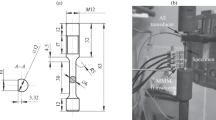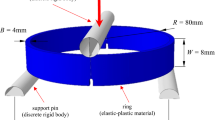Abstract
The state, problems, and prospects of conventional, unified and special laboratory, bench and full-scale tests to substantiate the systematic assessment of strength, durability, survivability, cold resistance, reliability, and safety of the key elements of pipeline transport of crude oil and refined products are considered. These tests correlate with the stages of the pipeline life cycles and basic and reference computational-experimental methods of determining the criterial characteristics of pipe steels, pipes and main pipelines with regard to domestic and foreign practices. The experimental basic mechanical characteristics obtained in standard static tensile tests (yield and strength limits, elastic moduli) are part of the basic static strength calculations of newly designed and operating pipelines. Standard hardness and impact elasticity tests are used to control the pipe steel quality. The results of standard tensile tests provide additional design information for the assessment of static strength with respect to the ductility and degree of steel hardening during elastoplastic deformation. Unified laboratory tests are meant for refining the pipeline strength with allowance for the stress state 3D effects, absolute sizes of the pipeline cross section, strain rate, anisotropy, cold resistance, corrosion, and the presence of welded joints. The assessment of pipe steel crack resistance and pipes according to the criteria of linear and nonlinear fracture mechanics with allowance for technological and operational defects holds a specific place in laboratory and bench testing. The experience in conducting these tests, accumulated in the Russian oil pipeline system is considered.











Similar content being viewed by others
REFERENCES
Bezopasnost’ Rossii. Pravovye, sotsial’no-ekonomicheskie i nauchno-tekhnicheskie aspekty. Energeticheskaya bezopasnost' (Neftyanoi kompleks Rossii) (Security of Russia. Legal, Social-Economic and Scientific-Technical Aspects. Energy Safety (Energetic Complex of Russia)), Moscow: Znanie, 2000.
Bezopasnost’ Rossii. Bezopasnost’ truboprovodnogo transporta (Security of Russia. Safety of Pipeline Transportation), Moscow: Znanie, 2002.
Mazur, I.I. and Ivantsov, O.M., Bezopasnost’ truboprovodnykh sistem (Safety of Pipeline Systems), Moscow: Elima, 2004.
Oding, I.A., Dopustimye napryazheniya v mashinostroenii i tsiklicheskaya prochnost’ metallov (Allowable Stresses in Machine Engineering and Cyclic Strength of Metals), Moscow: Mashgiz, 1962.
Streletskii, N.S., Geniev, A.N., Belenya, E.I., et al., Metallicheskie konstruktsii (Metal Constructions), Moscow: Stroiizdat, 1961.
API 579-1/ASME FFS-1-Fitness-for-Service, Houston, TX: Am. Soc. Mech. Eng., 2007.
DNV RP-F101: Corroded Pipelines, Practical Guidance, Recommended Practice, Oslo: DNV GL, 2017.
Radionov, S.G., Lisin, Yu.V., Makhutov, N.A., et al., Scientific, technical, socio-economic, and legal aspects of reliability of transportation of petroleum products, Nauka Tekhnol.–Truboprovodn. Transp. Nefti Nefteprod., 2016, vol. 6, pp. 20–31.
Makhutov, N.A., Prochnost’ i bezopasnost’: fundamental’nye i prikladnye issledovaniya (Strength and Safety: Fundamental and Applied Research), Novosibirsk: Nauka, 2008.
Makhutov, N.A. and Permyakov, V.N., Resurs bezopasnoi ekspluotatsii sosudov i truboprovodov (The Resource of Safe Operation of Vessels and Pipelines), Novosibirsk: Nauka, 2005.
Lisin, Yu.V., Neganov, D.A., Makhutov, N.A., and Zorin, N.E., The scale effect in the strength analysis of pipelines, Neft. Khoz., 2017, no. 6, pp. 112–116.
Makhutov, N.A., Konstruktsionnaya prochnost’, resurs i tekhnogennaya bezopasnost’. Chast’ 1. Kriterii prochnosti i resursa. Chast’ 2. Obosnovanie resursa i bezopasnosti (Construction Strength, Resource, and Technogenic Safety, Part 1: Criteria of Strength and Resource; Part 2: Substantiation of Resource and Safety), Novosibirsk: Nauka, 2005.
Neganov, D.A., Studenov, E.P., Skorodumov, S.V., and Solov’ev, V.A., The Study of structures hydraulic stands for testing of pipe products, Nauka Tekhnol.–Truboprovodn. Transp. Nefti Nefteprod., 2017, no. 2, pp. 31–41.
Lisin, Yu.V., The physicochemical properties of steel for long-operated pipelines: Assessment of the resource of safe operation, Nauka Tekhnol.–Truboprovodn. Transp. Nefti Nefteprod., 2015, vol. 7, pp. 18–28.
Larionov, V.P., Svarka i problemy khrupkogo razrusheniya (Welding and Brittle Fracture), Novosibirsk: Inst. Fiz.-Tekh. Probl. Sev., Sib. Otd., Ross. Akad. Nauk, 1998.
RD (Ruling Document) 23.040.00-KTN-011-16: Main Pipeline Transport of Oil and Petroleum Products. Determination of the Strength and Durability of Pipes and Welded Joints with Defects), Moscow: Transneft’, 2016.
ACKNOWLEDGMENTS
This work was supported by the Russian Foundation for Basic Research, grant no. 16-58-48008_Ind_Omi.
Author information
Authors and Affiliations
Corresponding author
Additional information
Translated by A. Kolemesin
Rights and permissions
About this article
Cite this article
Lisin, Y.V., Makhutov, N.A., Neganov, D.A. et al. Integrated Mechanical Strength Tests of the Main Pipeline for Transporting Crude Oil and Refined Products. Inorg Mater 55, 1465–1475 (2019). https://doi.org/10.1134/S0020168519150093
Received:
Published:
Issue Date:
DOI: https://doi.org/10.1134/S0020168519150093




